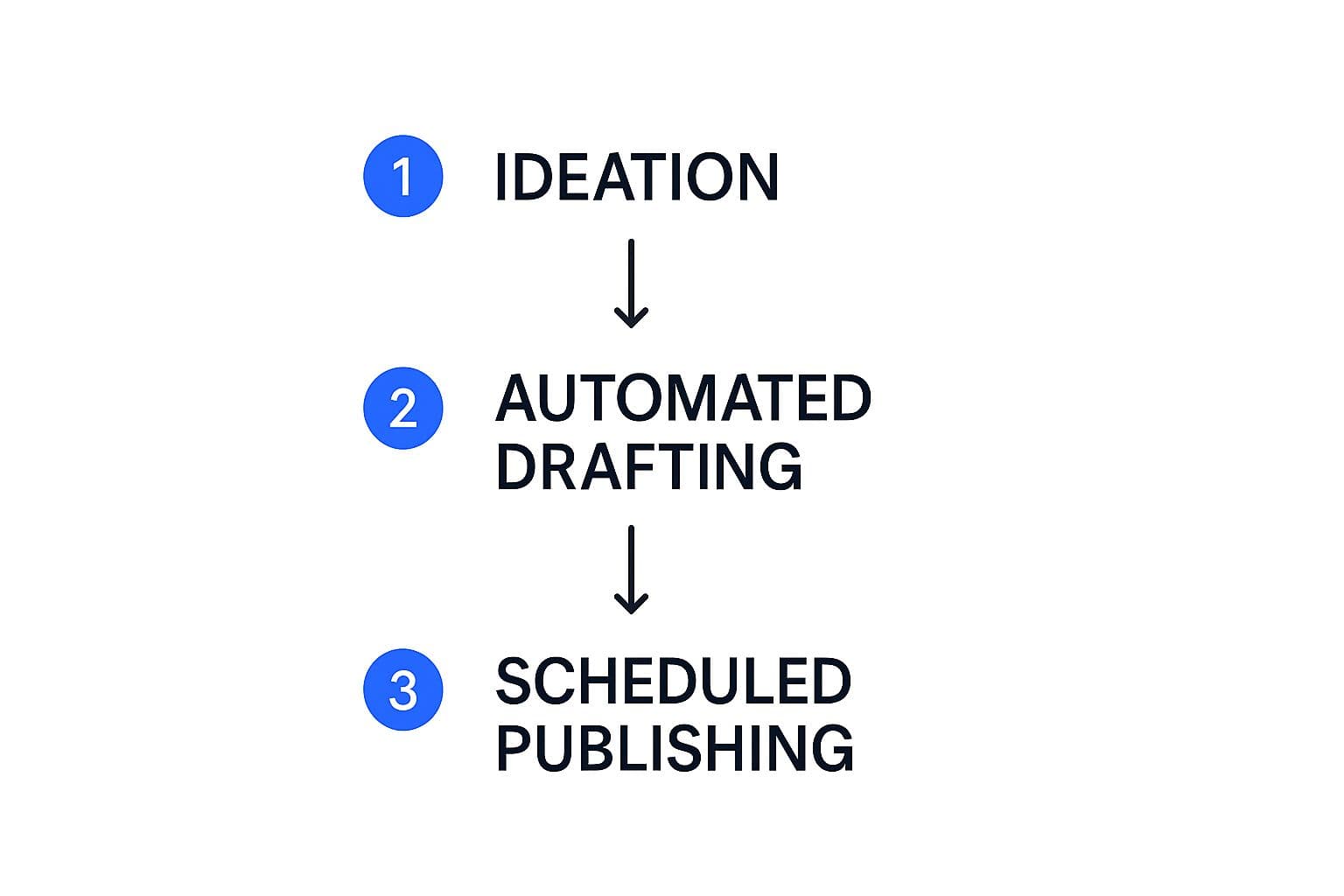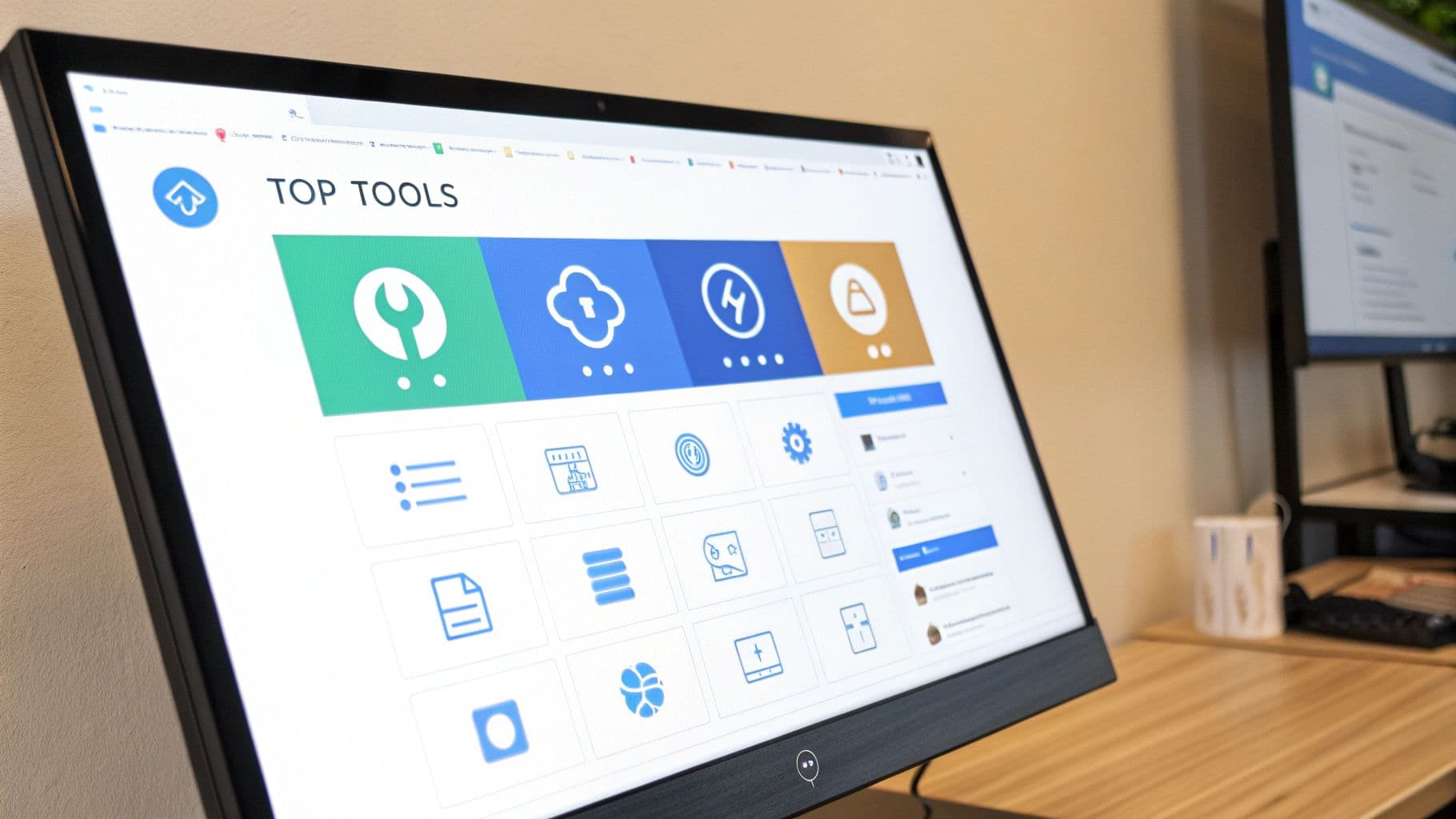Unlock Success with Content Creation Automation Strategies
Discover effective content creation automation tips to save time and boost creativity. Transform your workflow today!

Understanding Content Creation Automation Beyond Efficiency
Imagine you're a chef, about to create a culinary masterpiece. Now, imagine a skilled sous chef by your side, prepping ingredients, organizing the kitchen, and handling all the repetitive tasks. That's content creation automation – your trusty sous chef in the digital kitchen. It frees you, the chef, to focus on the creative magic: developing unique recipes (content strategy) and plating beautiful dishes (engaging content). It's about empowering creators, not replacing them.
Reframing Automation as a Creative Partner
Many creators initially worry that automation will replace their creative spark. But the truth is, it's just the opposite. Think of how automation has helped other industries. Take field service, for example. Tools and processes like those described in Field Service Automation Tips help technicians be more efficient, freeing them to focus on more complex problems. Content creation is no different.
Automating tedious tasks like research and formatting, or even parts of the writing process itself, gives you back valuable time and mental space. This allows you to focus on the truly creative work: brainstorming new ideas, refining your brand's voice, and crafting compelling narratives.

From Chaos to Symphony: Orchestrating Your Workflow
Content creation without automation can feel like a chaotic juggling act. You're constantly switching between research, writing, editing, scheduling, promotion, and analyzing performance. It's exhausting. Automation brings order to this chaos, transforming it into a well-orchestrated symphony.
Picture this: automated systems gathering research, scheduling social media posts, and even creating initial drafts. You become the conductor, setting the creative direction, refining the message, and ensuring all the elements work together harmoniously. This is especially important in today's rapidly growing market; the global digital content creation market is expected to hit $31.93 billion in 2025**, up from **$27.99 billion in 2024. This growth underscores the need for smart automation to manage the increasing complexity. Discover more market insights.
The Power of Amplified Creativity
At its core, content creation automation is about amplifying human creativity. By handling the repetitive, time-consuming tasks, it allows creators to focus on what they do best: connecting with their audience on a deeper level, experimenting with new content formats, and telling captivating stories. Embracing automation as a creative partner, not a threat, is key to thriving in today's dynamic content landscape.
Hidden Benefits That Transform Your Creative Process

Beyond simply saving time, automating your content creation offers some surprising advantages that often get overlooked. Imagine effortlessly maintaining a consistent brand voice across all your articles, or finally having the mental space to brainstorm truly innovative ideas because the routine tasks are handled automatically. These are the hidden benefits we'll explore – the perks that go beyond basic efficiency.
Reducing Decision Fatigue for Enhanced Creativity
Every decision we make, no matter how small, takes a little bit of mental energy. Content creators face a constant barrage of choices every day – from picking topics and researching keywords to crafting headlines and finding the right images. This constant decision-making can lead to decision fatigue, which blocks creativity and can result in less effective content.
Automation helps lighten this mental load. By automating repetitive tasks, you free up mental bandwidth for the strategic, creative thinking that truly matters. Think of it like decluttering your mind to make room for inspiration.
Minimizing Human Error and Ensuring Quality
Even the most detail-oriented creators make mistakes. Typos, grammatical errors, and inconsistencies can slip through, impacting your credibility. Content creation automation acts like a safety net, minimizing those human errors. Tools like Grammarly can automatically check for grammar and flag plagiarism, ensuring consistent formatting across your content.
This not only improves the overall quality but also frees you from tedious proofreading, giving you more time for the creative aspects of content creation. You might also consider tools like TypeBoost's AI Writing Assistant to explore even more automation possibilities.
Enabling Personalization at Scale
Connecting with your audience on a personal level is essential. But as your content volume grows, tailoring it to individual needs becomes increasingly difficult. This is where content creation automation truly shines.
Think of automated email sequences that greet subscribers by name and suggest products based on their past purchases. This level of personalization, once impossible to do manually at scale, is now achievable through automation.
Fueling Experimentation and Innovation
Imagine the freedom to experiment with new content formats, explore the latest trends, and push your creative boundaries without the weight of repetitive tasks holding you back. Content creation automation makes this a reality.
By offloading the routine, you create the time and mental space for true innovation. This newfound freedom empowers you to take creative risks and explore uncharted territory, leading to potentially groundbreaking content that truly resonates with your audience. This is reflected in the marketing world, where by 2025, 77% of marketers are projected to use AI-powered automation for personalized content, achieving a $5.44 return for every dollar invested. Discover more insights on marketing automation.
Unleashing the Power of Focus and Flow
Constantly switching between tasks shatters focus and disrupts your creative flow. Automation allows you to concentrate on what’s called “deep work” – the kind of focused effort that leads to truly exceptional content. Imagine dedicating uninterrupted blocks of time to crafting compelling narratives, developing thought-provoking insights, and building authentic connections with your audience.
This deep focus, facilitated by automation, unlocks a state of flow, where creativity flourishes and innovative ideas emerge.
To better understand the impact of automation, let's look at a comparison of manual versus automated content creation:
The following table illustrates the potential Return on Investment (ROI) you can achieve by automating your content creation process.
ROI Comparison: Manual vs. Automated Content Creation Analysis of time investment, cost savings, and output quality between traditional and automated content creation approaches
| Metric | Manual Process | Automated Process | Improvement |
|---|---|---|---|
| Time per Article | 8 hours | 2 hours | 75% reduction |
| Cost per Article | $500 | $100 | 80% reduction |
| Number of Articles per Week | 2 | 8 | 4x increase |
| Error Rate | 5% | 1% | 80% reduction |
| Content Consistency | Moderate | High | Significant improvement |
As you can see, automation significantly reduces the time and cost associated with content creation while simultaneously increasing output and improving quality and consistency. This allows content creators to focus on higher-value tasks like strategy and creative development.
Building Your Automation Workflow From Chaos To Clarity
Creating a truly effective automation workflow for content creation isn't about throwing technology at the problem and hoping for the best. It's more like carefully designing a river system. You need well-defined channels (processes), a smooth, consistent flow (seamless integration), and strategically placed tributaries (automation tools) all leading to your ultimate goal – a steady stream of high-quality content. Many teams get bogged down trying to automate every single thing at once. This often leads to more confusion than actual improvement. A more measured, strategic approach is key.
Mapping Your Content Creation Journey
The first step in building a successful automation workflow is understanding your current process, warts and all. Think of it like tracing the path of a river from its source, high in the mountains, all the way to the ocean. Similarly, map out every step in your content creation process. Start with initial brainstorming and drafting, then follow the path through editing, publishing, and finally, promotion. This careful mapping will highlight any bottlenecks or pain points and reveal the areas most ripe for automation.
Identifying Automation Opportunities
Once you’ve mapped your current workflow, it's time to start looking for opportunities. Specifically, look for repetitive, time-consuming tasks that could be handled by software. Think of these as the low-hanging fruit – easy wins that free up your team for more strategic work. Some common examples might include:
- Research and Data Gathering: Automating parts of your research process, such as keyword research or competitor analysis, can save hours of manual work. Tools like Semrush can be incredibly helpful here.
- Content Repurposing: Why create content from scratch every time? Automating the repurposing process allows you to efficiently transform blog posts into social media snippets, email newsletters, or even short videos.
- Social Media Scheduling: Tools like Buffer and Hootsuite make it easy to plan and schedule your social media posts in advance, ensuring a consistent presence without constant manual intervention.
- Grammar and Style Checking: Automate proofreading and editing to maintain consistency and catch those little errors that can slip through even the most careful human eye. Grammarly is a popular choice for this.
This infographic visualizes a simplified automation workflow:

The infographic shows how content can flow from the initial idea stage through automated drafting and finally to scheduled publishing, highlighting the core stages where automation can have a significant impact.
Balancing Human Creativity and Automated Efficiency
The real magic of content creation automation lies in finding the sweet spot between human creativity and the efficiency of automation. The goal isn't to replace your team with robots, but rather to empower them. Think of automation as a powerful tool that frees up your team to focus on the higher-level, creative tasks that require human ingenuity. Things like crafting compelling narratives, developing insightful analyses, and implementing innovative strategies.
Zapier's visual interface emphasizes how easily different platforms can be integrated for automated content creation and distribution. It showcases the potential for streamlining complex, multi-step tasks.
Building a Sustainable System
Building a sustainable content creation automation workflow takes planning, patience, and a willingness to adapt. Start small, perhaps by automating just one or two key tasks at a time. This gives your team time to adjust to the new processes and provides valuable feedback for optimizing your overall automation strategy. Remember, content creation automation is a continuous journey, not a one-time fix. Regularly evaluate and refine your workflow to ensure it continues to meet your evolving content needs. By following these principles, you can transform your content creation process from a chaotic mess to a well-oiled machine, maximizing both efficiency and creative output.
Choosing The Right Tools For Your Content Arsenal

Picking the right content creation automation tools can feel overwhelming. The market is flooded with options, each promising to be the ultimate solution. But instead of chasing the latest, greatest features, think about building your content automation toolkit like putting together a band. You need each instrument (tool) to play its part in harmony, not a bunch of soloists competing for attention.
Matching Tools To Your Specific Content Needs
First, take a look at your existing content workflow. Where are the biggest hold-ups? Are you stuck staring at a blank page, bogged down in tedious edits, or struggling to keep up with social media posting? Maybe you need help with keyword research or repurposing content into different formats. Figuring out your pain points will lead you to the right tools.
For example, if your team is spending hours every week scheduling social media updates, a tool like Buffer or Hootsuite could be a lifesaver. But if your main goal is to improve the writing process itself, AI-powered writing assistants like TypeBoost might be a better fit. Understanding your specific needs is the key to choosing the right tools. You might also find value in exploring how stored AI prompts can boost efficiency with TypeBoost: exploring how stored AI prompts can boost efficiency with TypeBoost. This can have a substantial positive impact on your content process.
Evaluating Content Automation Platforms
Once you know what you need, you can start looking at different platforms. Don't just take the marketing materials at face value. Dig deeper and find real user reviews and case studies. Ask important questions: How easily will this tool fit into my current workflow? How long will it take to learn? Is there good customer support?
The world of content creation automation has changed significantly with the rise of AI tools. As of 2025, 47% of sales professionals are using generative AI for content creation, and another 43% are using automation tools. This shows how important it is to bring these technologies into your content strategy: Discover more insights on automation statistics.
Building A Scalable Tech Stack
When choosing tools, think long-term. Pick solutions that can grow and adapt with your business. Don't get trapped in inflexible contracts or platforms. To get a better idea of how automation can work for you, take a look at some real-world business process automation examples.
A modular approach lets you add or remove tools as your needs change, keeping your content creation process nimble and efficient. The goal is to build a system that helps you create great content, not one that gets in the way. This helps avoid the problem of having too many disconnected tools, which can make things more complicated instead of simpler. Prioritize integration and interoperability to create a smooth, efficient content workflow.
To help you choose the right platforms, we've compiled a comparison of some leading content automation tools:
Implementation Strategies That Actually Work
Rolling out content creation automation isn't like flipping a switch. It's more like learning to drive. You wouldn't jump straight onto the highway, would you? You'd start in a quiet parking lot, getting comfortable with the controls and gradually building your skills and confidence. Content automation is similar – it requires a strategic, phased approach. Too many teams try to automate everything at once and end up overwhelmed, often overlooking the crucial human element.
Starting Small and Building Momentum
The best way to implement automation is to start small and manageable. Instead of a complete overhaul, identify one or two areas where automation can have an immediate impact. Think about automating social media scheduling with a tool like Buffer, using a grammar checker like Grammarly, or even automating parts of your research process. By starting small, you minimize disruption, give your team time to adapt, and build momentum for more ambitious automation projects later on.
Navigating Resistance and Fostering Adoption
Introducing any new technology can sometimes meet resistance. Team members might worry about their roles or simply be uncomfortable with changes to their workflow. Addressing these concerns directly is key. Open communication, clear explanations of the benefits, and opportunities for feedback and training are essential.
For instance, instead of focusing on tasks being eliminated, show how automation frees up time for more creative work. Explain how it empowers the team to focus on strategy and develop new skills. If you position automation as a collaborative partner, you can build genuine enthusiasm and make the transition much smoother.
Setting Realistic Expectations and Measuring Progress
It's crucial to set clear, realistic expectations from the outset. Automation isn’t a magic solution; it’s a tool that needs careful implementation and ongoing refinement. Define specific, measurable goals for your automation efforts. Are you aiming to reduce content creation time? Increase output? Improve content quality? Track your progress against these goals regularly and celebrate your wins to reinforce the value of automation across the team.
The Human Side of Technological Transformation
Successful content automation is all about change management. While the technology is important, the human factor is often what determines success or failure. Support your team throughout the transition, offering training and resources to help them adapt to the new automated workflows. This human-centered approach builds trust, eases anxieties, and ensures that everyone feels empowered by the changes, not threatened by them.
Scaling Your Automated Systems for Growth
As your content needs grow and your team expands, your automated systems need to scale too. Choose tools and platforms that offer flexibility and integrations so you can adapt to future needs without disrupting your workflow. Regularly review your automation strategy and make adjustments as needed, making sure your systems continue to support your evolving creative vision and your team’s long-term success. This proactive approach to scaling helps you unlock the full potential of content creation automation and maximize its impact on your content strategy.
Avoiding Common Automation Pitfalls and Maximizing Success
Even with the best intentions, content creation automation can sometimes go off the rails. Think of it like a GPS: it’s usually great, but occasionally it leads you down a dead-end street. Automation tools can be similar – incredibly helpful, but potentially problematic if not used thoughtfully. One of the biggest traps? Automating broken processes instead of fixing them first. Let’s explore some common missteps and how to steer clear of them.
Automating Broken Processes: The Biggest Trap
Imagine trying to automate a leaky faucet. Sure, you could install a fancy automatic timer, but you’re still wasting water. Automating a flawed content creation process is just like that – it amplifies existing problems. Before you introduce automation, take time to analyze your current workflow. Where are the bottlenecks? The inefficiencies? Fix those leaks before automating the flow.
Losing the Human Touch: Maintaining Authenticity
Automation excels at efficiency, but it can’t replicate the genuine human element that makes content truly resonate. Think of a beautifully handwritten letter versus a generic, automated email. The email is faster, but the letter has a personal warmth and authenticity that’s hard to match. In your content creation automation strategy, prioritize maintaining that human touch. Focus automation on repetitive tasks like scheduling and formatting, freeing up your team to focus on the creative work that requires human ingenuity.
Neglecting Regular Audits and Optimization: Staying on Track
Automation isn’t a “set it and forget it” solution. Like a garden, your automated systems need regular tending to truly flourish. Continuously monitor your workflows and look for areas that need adjustment. Are your tools still meeting your needs? Are there new opportunities for automation? Regularly audit and optimize your systems to ensure they're still serving your creative vision.
Over-Reliance on Tools: Remembering the "Why"
Tools are essential for content creation automation, but it’s important not to lose sight of the bigger picture: your content goals. Use tools strategically to achieve those goals. Don’t get caught up chasing the newest features. Choose tools that genuinely support your overall content strategy. Remember, the tools serve your creative vision – not the other way around. You can learn about some helpful marketing AI tools here: Check out our guide on marketing AI tools.
Ignoring the Learning Curve: Investing in Training
Implementing new automation tools requires an investment in training and onboarding. Don’t underestimate the learning curve. Provide your team with the resources and support they need to truly master the new systems. This upfront investment will pay off in the long run, ensuring smooth adoption and maximizing the benefits of automation.
Failing to Measure Results: Demonstrating Value
How do you know if your content creation automation efforts are successful? Establish clear metrics and track your progress. Are you reducing production time? Increasing content output? Improving engagement? Measuring your results not only demonstrates the value of automation but also provides valuable data for ongoing optimization.
By understanding and avoiding these common pitfalls, you can set your content creation automation strategy up for success. Remember, the goal is to enhance your creative process, not hinder it. With a thoughtful approach, automation can be a powerful ally in creating compelling, engaging content.
Your Next Steps For Content Creation Success
Transforming your content creation with automation isn't about flipping a switch and instantly becoming a content machine. It's more like training for a marathon. You start small, build your stamina, and gradually increase your distance. This section offers a practical roadmap to help you implement content creation automation, one manageable step at a time.
Phase 1: Assessing Your Current State (Week 1-2)
Before you even think about automation, you need to understand your existing content creation workflow. Think of it like a doctor diagnosing a patient – you can’t prescribe a treatment until you know what you’re treating. What are the biggest bottlenecks slowing you down? Where are you spending the most time and energy?
- Deliverable: Map out your entire content workflow, from initial brainstorming all the way to promotion. Identify tasks that are repetitive and areas where things get bogged down.
- Success Metric: A clear visual representation of your current process that highlights areas ripe for automation. Think of this as your "before" picture.
- Troubleshooting: If you’re having trouble mapping your workflow, try using process mapping tools like Lucidchart or Miro. Getting feedback from your team can also be incredibly helpful.
Phase 2: Experimenting With Automation (Week 3-4)
Once you've identified areas for improvement, start small. Don't try to automate everything at once. Pick one or two tasks to automate first. This could be something like scheduling social media posts with a tool like Buffer or using AI writing software like Jasper to help with initial drafting.
- Deliverable: Implement your chosen automation tools for the selected tasks. Then, the crucial part: test and evaluate their performance. Are they actually saving you time and effort?
- Success Metric: Measurable improvement in efficiency for the automated tasks. For example, if you automated social media scheduling, are you now spending significantly less time on it each week?
- Troubleshooting: If you run into integration problems or the results aren't what you expected, check the tool’s documentation or contact their support team. Most tools have helpful resources to get you back on track.
Phase 3: Refining Your Workflow (Week 5-6)
As you get more comfortable with automation, you can start incorporating more advanced features. This might involve creating custom prompts for your AI tools or setting up more complex automated workflows using tools like Zapier or Make.
- Deliverable: Based on your initial experiments, fine-tune your automation tools and workflows. Think of this as tweaking the recipe to get the perfect dish.
- Success Metric: Increased efficiency and improved quality across your entire content creation process. You should be seeing improvements not just in the automated tasks, but in the overall flow of your work.
- Troubleshooting: If your automated processes feel clunky or ineffective, go back to your workflow map. Look for areas where you can simplify or optimize. Sometimes, less is more.
Phase 4: Scaling and Expanding (Week 7+)
With a solid foundation in place, you can start scaling your automated systems. This could involve integrating new tools, expanding your use of AI, and exploring more sophisticated automation strategies.
- Deliverable: Regularly evaluate your automated systems and make adjustments as needed. Just because something worked well in the past doesn't mean it's still the best approach.
- Success Metric: Sustained growth in content output and quality without sacrificing creative control. Automation should enhance your creativity, not replace it.
- Troubleshooting: As your systems become more complex, make sure you have proper documentation and training to support your team. This will prevent confusion and ensure everyone is on the same page.
By breaking down content creation automation into these phases, you can avoid feeling overwhelmed and build momentum over time. Remember, automation is a powerful tool, but it's not a magic solution. Consistent effort and a focus on continuous improvement are key to long-term success. Good luck on your automation journey! Why not try TypeBoost for free and boost your content creation workflow today?